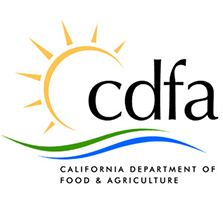Sacramento, CA…CDFA selected a research project titled “Small Dairy Climate Change Research: An economic evaluation of strategies for methane emission reduction effectiveness and appropriateness in small and large California dairies” for a grant award of $213,349. The research team is led by California Dairy Research Foundation in collaboration from University of California, Davis researchers.

This research is authorized by the Budget Act of 2017-18 which appropriated $250,000 to CDFA for small dairy climate change research. The research work will also contribute to the Small Dairy Climate Action Plan which is required by legislative mandate as part of the same budget act in 2017-18 (Item 8570-101-3228 (1) (b)).
The details of the funded project are below..
2018 CDFA Small Dairy Climate Change Research
Project Title: Small Dairy Climate Change Research: An economic evaluation of strategies for methane emission reduction effectiveness and appropriateness in small and large California dairies
Project Leader: Denise Mullinax, Assistant Director, California Dairy Quality Assurance Program
California Dairy Research Foundation
Research Collaborators: Prof. Daniel Sumner, Department of Agricultural and Resource Economics,
and Dr. Deanne Meyer, Department of Animal Science, University of California, Davis
Requested Amount: $213,349
Project Description
Senate Bill 1383 (SB 1383) specifically requires that methane emissions from dairy and livestock manure be reduced by 40% of 2013 levels by 2030.
Investment of public and private funds is necessary to reduce manure methane emissions. It is unknown if the best methane reduction strategies are similar regardless of dairy size. Understanding cost-effective and appropriate methane emission strategies for both small and large dairy farms is paramount to achieving the 40% reduction goal and ensuring efficient and effective investment of resources to achieve California’s goals.
This project includes seven objectives that match precisely the stated CDFA program priorities:
1. Categorize California dairies by herd size, animal housing, manure treatment and storage practices in order to evaluate best metrics for small and large dairies.
2. Quantify estimated methane emissions as low, high and average based on herd size (small and large), housing design and manure handling categories.
3. Review strategies and technologies currently or potentially used to reduce manure methane emissions for applicability to small and large dairies.
4. Compare economic impact of methane emission reduction strategies identified in Objective 3 on small dairies versus large dairies.
5. Compare whole-farm economic and environmental impacts of methane emission reduction strategies identified in Objective 3 on small and large dairies.
6. Compare methane reduction potential at small and large dairies, presented as a cost-benefit analysis of environmental and economic impacts on an estimated 1, 5 and 10-year scale.
7. Model and project sustainability (especially economic feasibility) of small dairies in California over an estimated 5, 10 and 20-year time scale in consideration of new environmental regulations including reductions for methane emissions, inflation, interest rates, feed prices, dairy product prices, labor costs and location of the dairies.
The project approach combines several data sources and methods to appraise how manure management and emissions strategies differ on small and large dairies and the impacts of alternatives. Multiple sources of publicly available data, select individual dairy information, and data from recent research will be used. Base dairy characterization information will be used to estimate low, high and average methane emissions for dairy herd distributions across regions and manure handling categories using the
Alternative Manure Management Program (AMMP) emissions calculator. CDFA and USDA dairy farm cost and returns data, as well as previous dairy finance research data and published economic sources will be used to develop economic simulation models for how methane strategies affect dairy farm choices, profitability and economic feasibility, with alternative milk, feed
2018 CDFA Small Dairy Climate Change Research
and labor price scenarios. Evaluations will allow us to indicate applicability and cost- effectiveness of methane emission reduction strategies to small and large dairies. Whole-farm environmental and economic assessments will be made to for both short-term and long-term sustainability.
The project leverages the extensive expertise of the uniquely qualified, California-based project team through collaborative efforts of the California Dairy Research Foundation and the University of California. Project success evaluation will be determined by successful delivery of several evaluation and assessment products, quarterly reports and a final report. CDFA expects this report to contribute ongoing work associated with legislative requirements for a Small Dairy Climate Action Plan which is required as part of the 2017-18 Budget Act (Item 8570-101-3228 (1) (b)).



Methane, increasing at about 7 parts per billion annually, is on track to run-up global temperatures by about 0.05°C by 2100 which is essentially unmeasurable.
Steve Case – Milwaukee, WI